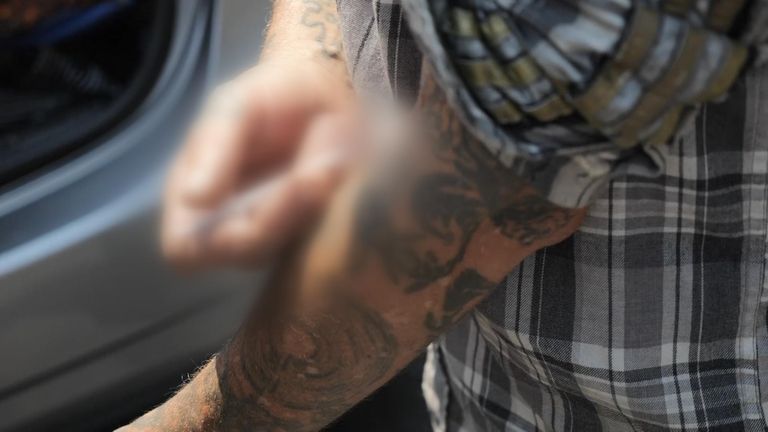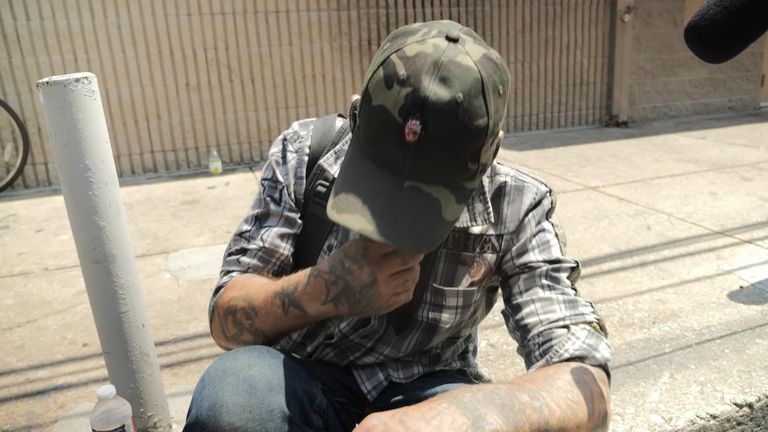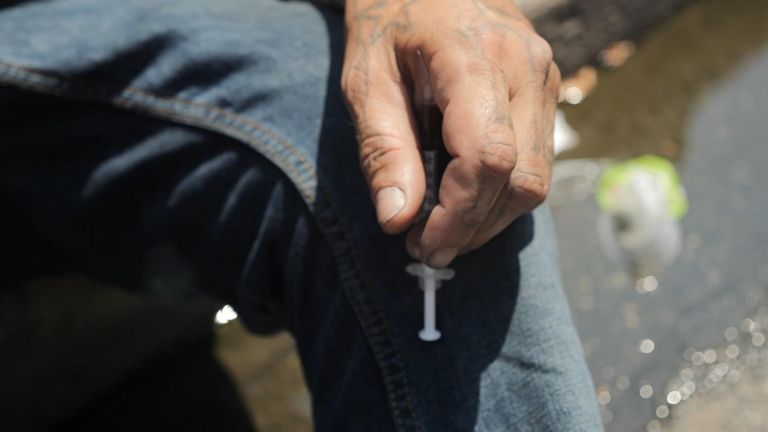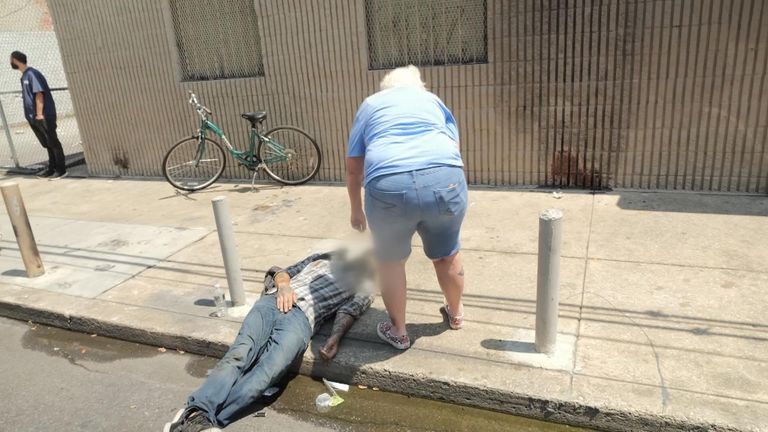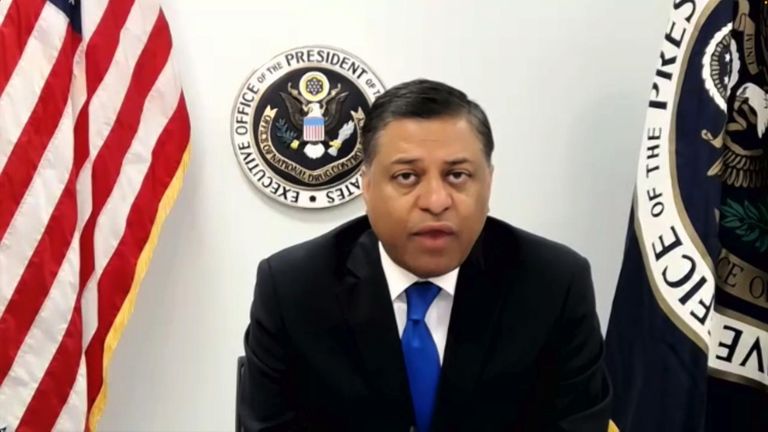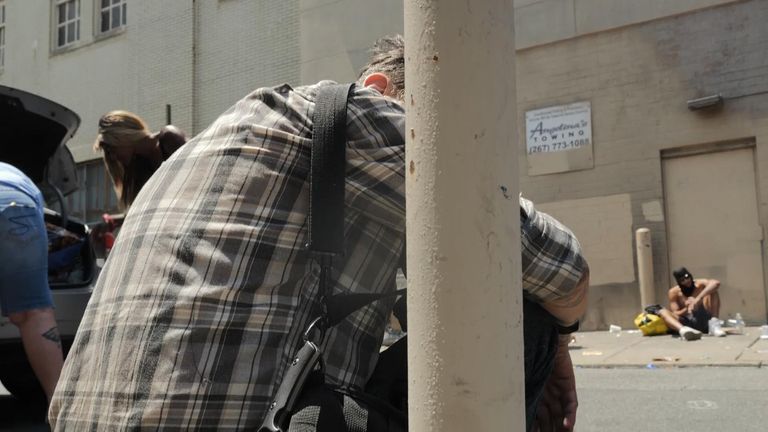After just 15 minutes on the streets of Philadelphia’s Kensington neighbourhood, an encounter that was everything.
It was illustrative of a crisis out of control, it was reflective of a profound personal struggle, it was instructive of the power of addiction, and it was deeply, deeply sad.
“I really didn’t have anybody taking me seriously,” Christophe said to me as he explained why he was where he was.
“I was this young guy, a semi-pro athlete.”
He explained how it had all begun with an injury.
Painkillers, prescribed at first, then self-medicated. Then illicit opioids. Now this new drug, Tranq.
He was fluent, eloquent, thoughtful, and as he told me his truncated life story, he was injecting himself in the left arm.
It didn’t take long. Seconds. He trailed off. A mumble.
Then nothing. His body stooped.
The hit had hit. He was almost out. He stumbled over to the curb and slumped down. Less than a minute later, he was unconscious.
I was last here in Philadelphia in February.
We’d gone then to investigate a new street drug which was leaving the most horrific wounds on those who use it. What we found then was shocking, devastating and truly depressing.
I’ve come back now because there’s news that the story of the so-called “zombie drug” has taken a turn.
America’s top drug prevention officials have been analysing nationwide data to see if this new drug, which had first emerged in these Philadelphia streets, is actually more widespread than they had thought.
What they have discovered is alarming.
New analysis of data stretching back to 2019 now shows a jump in Xylazine-related deaths of 276% nationwide. Deaths are more than doubling every year across America.
The drug, a cattle tranquiliser that is mixed by dealers into the existing opioid street drug supply, has now been detected in 48 of the 50 US states. Less than a year ago, they thought it had only been found in Philadelphia.
Regular unadulterated opioids are already killing more than 100,000 Americans every year. So news that xylazine is now so widespread is devastating for users, for volunteers and for the authorities who by our judgment have no control of this crisis.
Read more:
How drug leaves million-dollar streets strewn with bodies
‘Tranq’ designated ‘threat to the nation’
What is fentanyl?
In Philadelphia, I wanted to see how the users and volunteers I’d met back in February were doing and what they made of a major new “action plan” that President Biden has asked his officials to initiate.
Before Christophe had succumbed to his latest hit, he had seemed encouraged by the news from the White House.
Access to addiction treatment was key, he’d said.
Our guide through these dangerous streets was Ronnie Kaiser, who runs the charity Angels in Motion. She’d shown us around back in February and was keen to do so again.
I watched as she checked on Christophe.
“He has a pulse. He’s not overdosing at the moment,” she said.
The hopelessness here is breathtaking. There are people openly injecting on every street corner; far more than back in February, for sure.
Their addiction is more powerful than the recognition to treat the wounds which appear all over their bodies. Access to treatment – both physical and mental – is so hard. And there is so little in the way of a safety net in America.
“It’s gotten worse,” Ronnie said as we drove past one group of people, all unconscious.
Users must navigate America’s complex and expensive health system if they are to stand a real chance of recovery.
The government’s national plan involves access to prevention, harm reduction treatment and recovery support, as well as bold actions to disrupt the supply from China via Mexico.
“I’m glad they’re finally implementing something. I just hope that the implementation is fast enough and it’s the correct one. Most people here have either mental health or trauma that’s been in their life,” Ronnie told me.
She pointed to the perennial American problem of medical insurance and the “for profit” medical facilities.
“We need federal rehabs, federal recovery houses, the ability for longer rehab stays and definitely all insurances to be accepted at all rehabs,” she said.
Officials in the Biden administration do seem to be recognising the scale of the problem, but now with such profound challenges facing them.
Joe Biden’s director of national drug control policy, Dr Rahul Gupta, agreed to talk to us.
“On the streets here it looks like failure,” I said to him. “It looks like you have not remotely got a grip of the crisis here in Philadelphia and across the country.”
He conceded: “I think what you’re seeing and what I have seen on the streets of Philadelphia, specifically on Kensington Avenue, is an example of what does happen when we are not implementing those policies.”
“What I’ve seen is so much suffering. A lot of the people do not have homes. A lot of the people need help in an urgent way,” Dr Gupta said.
But he insisted the changes are having an impact: “The policy change that has occurred with prioritising harm reduction, prioritising treatment, meeting people where they are is working.”
Christophe took a few minutes to come around. The hits are intense, but they are short and, of course, highly addictive.
“Sorry,” he said. He wanted to finish his story.
